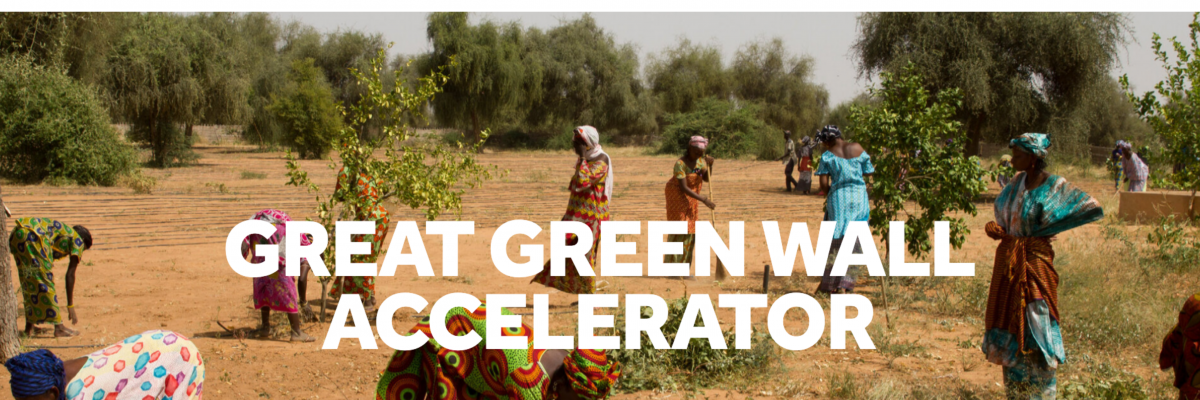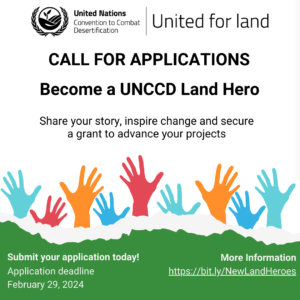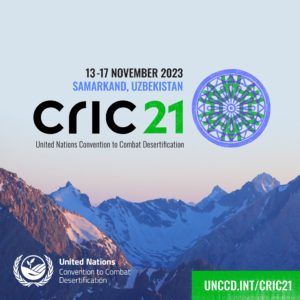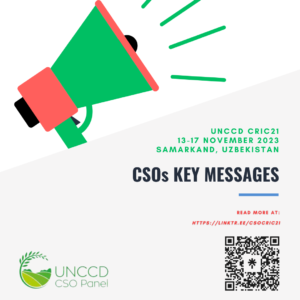In September 2020, the United Nations Convention to Combat Desertification (UNCCD) released the first report on the Great Green Wall implementation status and way ahead to 2030. This report showed a low level of achievement of the ambitious goals of the Great Green Wall (GGW), restoration of 100 million hectares, sequestration of 250 million tons of carbon and creation of 10 million green jobs. The environment ministers of the GGW countries then called on international partners to strengthen the coordination of efforts and financial commitments.
The One Planet Summit, hosted by France in January 2021, answered this call as the President of the French Republic launched a multi-stakeholder Great Green Wall Accelerator, through which several multilateral and bilateral organizations have committed to finance the GGW until 2025 up to 16.2 billion euros.
The accelerator aims to facilitate the coordination and collaboration of donors and stakeholders involved in the initiative. But also, to monitor and measure the impact of their actions. The accelerator will be coordinated by the Pan African Agency for the Great Green Wall (PAAGGW), with initial support from the UNCCD.
To inform civil society organizations and all actors involved in the GGW initiative about this accelerator, the NGO CARI has contacted the team established within the UNCCD to gather initial information.
Interview with the UNCCD team in charge of the GGW accelerator
Ms. Birguy LAMIZANA Senior Project Manager, Mr. Gilles OUEDRAOGO Monitoring Officer, Ms. Sarah TOUMI Monitoring Officer, Mr. James BIGILA External Relations Officer, Mr. Maxime THIBON Advisor to the Executive Secretary
Could you introduce the members of this team that will oversee the accelerator?
This is a small team of three people who were recruited in April 2021 to carry out the first missions of the accelerator. Sarah and Gilles will focus on setting up the monitoring and evaluation systems, and James will be responsible for communications. But they are not alone, they are supported by many colleagues from the Convention and all the services of the Convention. In addition, this team works closely with the Pan African Agency for the Great Green Wall.
What led to the establishment of the accelerator? What were the shortcomings?
These are the findings of the GGW implementation status report published in September 2020. In addition to providing information on progress, it highlights the main challenges and obstacles to implementation: the lack of integration of environmental issues into sector strategies, policies, and business plans; insufficient coordination and exchange of information on knowledge and good practices at the regional and national levels among GGW partners and countries; and gaps in program monitoring and evaluation to measure progress in GGW implementation.
The report’s findings prompted a call to action from the environment ministers of the Great Green Wall countries at the time of the report’s release. This call was well received by all the technical and financial partners who are already involved in the Sahelian zone.
The One Planet Summit (OPS) in January 2021 and its organization were then an opportunity to initiate and pursue discussions with these partners such as the World Bank, IFAD, and African Development Bank to mobilize one third of the financing objectives required by 2030, all in the spirit of a common and shared vision for better coordination of Great Green Wall activities with all partners. This is the spirit that we find in the framework of the accelerator.
The accelerator is structured around 5 pillars:
Pillar 1 – Investment in small and medium enterprises and strengthening of value chains, local markets, export organization
Pillar 2 – Land restoration and sustainable ecosystem management
Pillar 3 – Climate resilient infrastructure and access to renewable energy
Pillar 4 – Enabling economic and institutional framework for effective governance
Pillar 5 – Capacity building
How were these pillars identified?
These 5 pillars were defined following a consultation conducted by the One Planet Summit Secretariat as part of the organization of the Summit with technical and financial partners, countries and regional organizations (African Union, PAAGGW). These 5 pillars represent the new vision of the Great Green Wall as a rural development program based on integrated ecosystem management and corresponding to the stated objectives of countries on the resilience of ecosystems and populations.
What will be the detailed missions of the UNCCD Secretariat within the framework of the Accelerator?
The Accelerator is not a new structure, it is not an additional tool, and it should be complementary to existing GGW institutions, entities, and processes, and it will support them around three objectives
- To be able to better monitor ongoing activities in the field and to measure the progress made on the Great Green Wall on a more regular basis within a common accountability framework for countries and partners.
This will involve consultation with partners to build an accountability framework around harmonized indicators, capacity building of GGW agencies (national and pan-African) as well as their monitoring and evaluation systems, and the publication of an annual progress report and the organization of an annual monitoring meeting.
- Link available funding sources more effectively to project opportunities.
Previous discussions have shown that many project proponents, particularly from civil society, have proposals for action but no funding opportunities. Donors, on the other hand, say they do not receive
enough proposals for projects that contribute to GGW.
The accelerator will need to establish good coordination between current project owners, donors, implementers, and beneficiaries of the GGW, and this will require dissemination of the new accountability framework based on the five pillars of action. - Identify new funding opportunities for the GGW program. This involves both an appropriate follow-up of ongoing activities of multilateral and bilateral official development assistance partners. It also includes mobilizing additional funds from private and public sources for the implementation of the GGW.
The Accelerator team’s mission is therefore to:
- Ensure coordination among all GGW stakeholders, including member states, regional and international organizations, civil society organizations, academia, and private sector structures and institutions.
- Facilitate the implementation of the Great Green Wall initiative through a multi-stakeholder and structured approach based on 5 pillars of action.
- Provide a more comprehensive mapping of available funding and projects in need of funding, by monitoring and evaluating the impact of funded projects within a common framework across donors and countries.
- Enable better and more targeted communication on GGW at all scales.
- Monitor progress and ensure accountability of all actors for their commitments.
The team is currently designing systems to monitor and evaluate financial flows on GGW and progress. This involves extensive exchanges with all partners and national structures in the countries concerned.
All ongoing activities, especially on the monitoring framework, are done in full synergy with the Pan African GGW Agency and its experts. The African Union is also among the political partners with whom we are in regular contact.
What other actors do you plan to collaborate with? What collaborations are planned with civil society organizations?
Civil society and African regional organizations are among the partners that must be involved in the framework of the accelerator and its activities. Initial exchanges have already taken place with certain partners, but they need to be strengthened. To this end, we also regularly exchange with the departments in charge of partnerships and CSOs at the Convention.
Remember also that the accelerator is very young. Much remains to be done and we are aware of the importance of involving civil society. We hope to work with civil society to create a Great Green Wall label and bring together the “Great Green Wall community” to facilitate dialogue and cooperation with financial and state partners.
Specifically, what do you envision to fulfill the goal of more effectively connecting the funding sources already available with the project opportunities available?
The accelerator team is currently considering the idea of a networking and matchmaking platform. A consultation will be conducted to define and validate its functions and CSOs are among the partners that will be consulted.
At a conference on private investment in the Great Green Wall, organized by IUCN in March 2021, P. Burger (President of CARI) recalled that “in development, money alone is not enough. Stable governance and the law must guarantee the conditions in which investment can be made to be profitable, responsible, and sustainable. Most of the countries involved in the Great Green Wall are in unstable governance situations in the territories specifically targeted by the initiative.
How does the accelerator intend to play its “transformative” role in the face of this challenge?
Yes, Mr. Patrice Burger is right. Stable governance and land tenure security are among the necessary conditions for implementing territorial projects at all levels. This is strongly linked to Pillar 4 of the accelerator.
How does the 16.2 billion euros break down between loans and grants? All of the funds that were announced at the OPS are new funds. They are made up of loans, and grants, but also guarantees. These are funds that donors have committed to spend between 2021 and 2025 in the 11 GGW countries. Their distribution across the five pillars was announced at the conclusion of the OPS. However, an in-depth analysis of these funds is needed and is currently being conducted by the Accelerator team.
The accelerator would represent 30% of the funding needed to achieve the GGW’s ambitions by 2030. How will the accelerator leverage the remaining 70% of funding?
Through the establishment of a joint monitoring and evaluation system, regular reporting on progress, and the federation of all actors around common objectives, the accelerator’s mission is to demonstrate that by 2025, real progress will have been made and will be rigorously documented, so that financial partners will commit to financing larger-scale projects to achieve the objectives over the period 2026-2030.
What other sources of financing are considered for the Great Green Wall and what follow-up is planned to ensure that they are effectively mobilized?
In addition to the traditional development partners, the private sector made a strong commitment during the OPS to support projects and interventions in favor of ecosystem restoration and the development of agro-pastoral sectors in the GGW countries.
The LDN Fund, the IAM Africa multilateral initiative dedicated to agroecology in Africa and the World Economic Forum are among the private sector partners that have committed. The monitoring of their mobilization and intervention will also be part of the accountability framework that is being built. It is also necessary to mobilize and involve other development partners, be they national agencies, regional or international banks.
The 2020 GGW Implementation Status Report identified a lack of funds mobilized by countries among the challenges related to financing, as well as the weak capacity of these countries to put in place the required governance and project design to access and manage external financing.
How does the accelerator intend to address these challenges?
Although it is not one of the accelerator’s primary functions, particular attention will be paid to strengthening national GGW agencies, in a national coalition format, which should involve all national public actors (in charge of the environment, water, agriculture, livestock, economy and finance, and
planning) but also the private sector, the scientific and research community, and civil society.
Finally, in reading this 2020 report, CARI pointed out the absence of consideration of the actions undertaken by civil society organizations, local governments, and grassroots community organizations, which contribute at their own scale and because of their multitude to the realization of the GGW, through communication on the initiative, awareness raising and advocacy, capacity building of rural populations and local communities, some of which are linked to the Global Mechanism and IUCN, etc…
Does the accelerator aim to improve the connection of these small actors to the GGW initiative and their access to information, skills, and funding? If so, what courses of action are envisaged and through what mechanism?
Yes, and this is essential. This will be done through the exchange platform and the upcoming consultation of civil society actors, particularly in view of the IUCN, Africa-France and COP26 summits.






